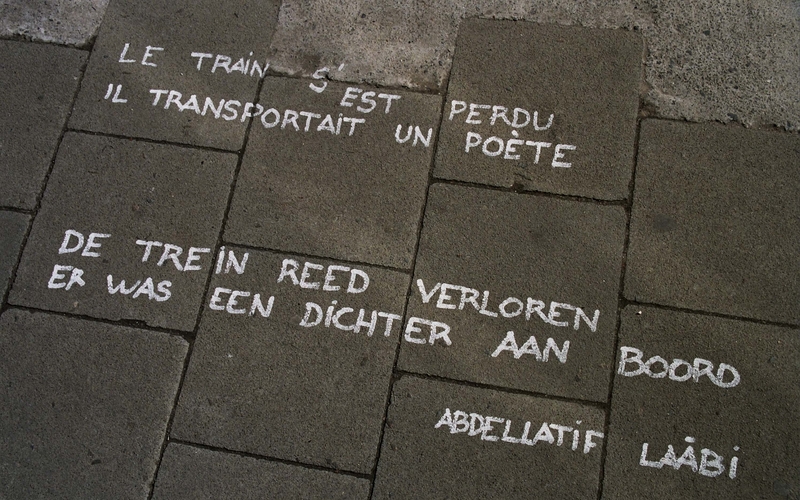(Di)Vers(e) Brussel. A bilateral alliance between art and poetry

Introducing art into the public space is often tricky: the art generally comes across as out of place in its new setting, and not as a time-tested connector with the surrounding environment. Art either relates to reality – or does not.
With ‘out of place’ art, a far-reaching, specialized knowledge of contemporary art is generally expected. For many, that is a high threshold, and it also contradicts the visualization of a potential mental-public ‘co-re-action’ that can emerge via a well-studied intervention of art in the public space.
The art is an a priori reaction against the chaotic dullness of a city like Brussels, in which today the quality of architecture, let alone the functional and community-shaping organization of the public space is hardly taken into account.
A project such as Vers Brussel – Poëzie in de stad introduces some much-needed diversity. Good artists are connected to good poets, who blow into the city from all corners of the world and add a Babel-iconic tone through a succession of 10 poetic-visual realizations. The works are to be found in various neighbourhoods, including and especially outside the hip city centre. What is striking is that most projects are nestled in the city’s armpits and creases, where they do not manifest themselves spectacularly.
The artworks are extraordinarily sensitive to their environment and would rather let themselves be surprised than be gawked at as showy artistic signs that willingly let themselves be placed in the current widespread use of art for lucrative and touristic city-marketing purposes.
Art in the public space is the ultimate artistic act for an artist. By placing art in the public space, the artist surrenders the privacy of his or her art, which today mainly finds a market in the closed context of the overheated, global-speculative circuits of the art market.
Art in the public space puts itself in a fragile position and does so without a target audience. For an artist, who today is unable to handle the competition of the crushing, monumental LED billboards, that is a small nightmare and a huge challenge. It is in fact remarkable that the advertising industry all too gladly recuperates the iconography of art in a substanceless system of tempting eye-catchers that fire up the urge to consume more. Art is not something you consume – art is something you sip, like a glass of vintage Brunello. And that is what happens with Vers Brussel.
Passers-by literally walk on poems (Henri Jacobs), read poetry on inconspicuous road signs (Christian Israel), are surprised by artificial poetry trees (Orla Barry) or walk under sculptural enlargements of lines of poetry (Els Opsomer). They are also often invited to take up a position at an ideal viewing point and to undergo or experience slowly the poetry of seeing (Filip Van Dingenen, Peter Weidenbaum). The visualization of poems is artistically diverse and reflects the gentle intention of the artists to blend word and image into a multifaceted experience.
One poem was even buried with an audio recording on a Brussels square, as a once-to-be-(re)discovered archaeological artefact – a rousing and tentative gesture that speaks to the imagination, a gesture by two artists (Sophie Nys and Richard Venlet) who literally put a lock on the (temporarily) unreachable language. This radical artwork places nothing in the street but refers to the flickering, subterranean imagination; an idea towards which Marcel Duchamp in particular was well disposed and which, after his death, even led to the discovery of his much-discussed work Etant donnés.
The absurdity of manoeuvring in and between language and image forms in the project Vers Brussel the core thought of an intense striving after visual eloquence between visual artists and poets.
Art is not easy to reconcile with everyday life. The combination of language and image is and remains a risky conceptual exercise. Think of René Magritte’s painting The Son of Man, which shows an alluring apple on the face of a bourgeois. Between the title of the artwork and the layered motif that can make the imagination run wild, confusion and alienation emerge.
Artists know how to turn doubts and uncertainties into an unseen language, in which thoughts get stuck as though in a heavenly labyrinth. The language of the image then turns into the representation of ‘another’, free language, which works poetically and as a result can keep the objective reality concealed.
Vers Brussel offers the city a delightful new ‘wiring’ in which poets and visual artists express their passion for a metropolis that does not tolerate any fossilized identity. The freedom of the collective difference is celebrated in sculptures and language forms that together make up – and make over – the world.